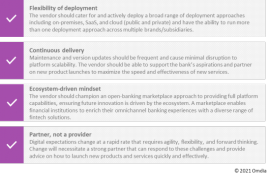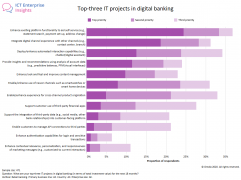State of play: digital banking platforms
Introducing a new regular column – State of Play – at FinTech Futures. Each month, fintech analyst Philip Benton explores a new topic and assesses the “state of play”, providing an in-depth analysis and understanding of the market landscape.
This month we are diving into digital banking platforms.
Implementing a next-generation digital banking platform (DBP) will enhance digital self-service customer journeys and empower wider employee-to-customer interactions, irrespective of any limitations in legacy systems.

Retail banks should view their software provider as a partner, not a vendor
With an increasingly crowded vendor marketplace and every bank’s requirements being unique, selecting the right platform is a lengthy process that requires careful consideration. A modern digital banking platform should provide the institution with the capability to easily build new products/services and rapidly deploy at scale to ensure banks can keep pace with consumers’ demands.
While the platform capabilities (and ability to incorporate/develop new functionality) should be the core consideration, the vendor relationship is also crucial because a strong partnership will ensure that innovational goals are achievable.
Although there are many iterations of platforms that provide digital capabilities, this column focuses on platforms that provide digital capabilities for interaction and transactional services.
Omdia defines a digital banking platform as a standalone front-office solution that enables financial institutions to provide self-service capabilities on devices outside of the bank’s own network, typically without the need to overhaul their existing core banking systems.
Essential to any channel platform is its ability to support online and mobile banking for servicing, origination and customer interaction/communication. However, increasingly it is just as important to deploy a wider digital platform that supports the digital front office, where there is convergence between the human-centric (branch, contact centre) and digital-centric channels.
Evolution of the digital banking platform
The early iterations of DBPs were to give customers digital access to key banking and services. However, the other aspects of a customer journey — onboarding and origination or money management — were considered separate systems to the DBP.
Since the introduction of mobile banking, the DBP has evolved to manage the whole customer lifecycle. Similarly, it has shifted from customer access and transaction-centric services to interaction and customer engagement, which now form part of a broader omnichannel strategy.
While digital banking platforms were originally designed to mask offline processes with an online layer, today the expectations are very different. Customers expect to be onboarded in minutes, have access to financing instantly and for transactions to be conducted in “real time”.
Today, a modern digital banking platform should have a catalogue of base product features while providing flexibility for banks to easily add new products and services themselves. A key function of a digital banking platform is to facilitate an omnichannel approach that provides internet, mobile and possibly conversational interfaces while ensuring that users are not unnecessarily restricted in their interaction or transaction by the device used (i.e., biometric authentication can only legitimately function via mobile).
While branch, call centre, internet and mobile are the most common distribution channels, the digital banking platform should be able to cater for emerging channels such as chatbots, wearables and Internet of Things (IoT) as customer expectations evolve and demand them. This ensures that the customer journey can be effectively managed from whichever channel they choose to interact with the bank.
Selecting a partner for the long-term digital transformation journey
Historically, banks would strategise IT investment by deciding to either build, buy or outsource. However, as the market has matured and the pace of technology development has accelerated alongside increased demand for a breadth of requirements, there has been a shift to a platform approach that combines vendor capabilities and co-innovation with the bank.
Having control of the platform is critical to banks since the quality of platform capabilities and experience drives business outcomes. The flexibility and customisation of modern platforms have pushed banks to seriously consider using an external platform from a specialist provider, although some banks (typically Tier 1 or fintech start-ups) will still choose to build their own or select a platform that provides more of a framework over a packaged solution.
Consequently, the DBP vendor marketplace has become increasingly crowded with platforms ranging from development platforms/ toolkits to allow banks to develop their own services, to highly packaged off-the-shelf services. The vendor landscape consists of a mixture of global and local players but also those from industry-specific backgrounds such as payment processing and core banking.
Horizontal technology providers with platforms that have origins in app development, digital experience and customer engagement/marketing are increasingly adding digital banking to their platform capabilities to offer a more comprehensive service to their banking clients, which means that the list of potential vendors is endless.
The below table outlines the key features to look for in a partner when selecting the shortlist for your digital banking platform provider.
Vendor experience key features checklist

To support the accelerated go-to-market delivery, it is increasingly important to deploy in the cloud, with software-as-a-service (SaaS) increasingly in demand to ensure continuous delivery and keep pace with technological advancement.
When selecting a vendor, it is important to review whether it can offer multiple deployment approaches as it is unlikely that the same deployment method will be appropriate across all sites, particularly if operating on a multi-geography basis.
To maintain competitiveness, the platform should enable continuous innovation with minimal disruption to the day-to-day business when maintenance or version updates are required; this is another reason to consider SaaS deployment.
Although the platform must have broad functionality, the vendor ecosystem should not be discounted as it provides the opportunity to tap into a multitude of niche suppliers through their marketplace. Future innovation is likely to be driven through the ecosystem, benefitting the bank in the long term by unlocking advantages beyond the platform.
The digital banking platform supports and enables wider digital transformation but the relationship between vendor and bank is equally important in terms of driving innovation and change within the bank. Banks should select partners with digital expertise and industry domain and enterprise-grade capabilities, as well as a digital-mindset approach to innovation.
Therefore, banks should look beyond core providers, although many banking software vendors have considerably developed their digital capabilities. It requires a partner that can be trusted to respond quickly to challenges as they arise and recognise and respond to the difficulties a bank is facing on a real-time basis. Thus, the supplier should be viewed as more than just a vendor.
Market outlook
The COVID-19 pandemic has accelerated an already high demand for digital banking solutions, with more than a third of retail banks having significantly increased their online and mobile banking priorities because of it, according to Omdia’s ICT Enterprise Insights 2020/21 survey.
Consequently, global spend on digital banking is expected to grow at a CAGR of 5.5% to reach $17 billion in 2025, compared with $13 billion in 2020, proving there is plenty of market share available for digital banking platform vendors.
However, it is expected that there will be a period of consolidation among banking software vendors, which would continue the trend of mergers and acquisitions that has occurred in the fintech industry during the past two years, particularly if big tech elects to get involved.
The evolution of digital banking platforms requires banks to continually invest in the technology, the top priority being to enhance existing platform functionality to aid self-service, according to Omdia’s ICT Enterprise Insights 2020/21 survey.
Although retail banks intend to use a digital banking platform to aid self-service, they also want to integrate the digital channel experience with other channels, which is the top priority for 19% of respondents. That requires platforms to have strong omnichannel capabilities.
Enhancing self-service platform functionality is number one priority for retail banks

Source: Omdia ICT Enterprise Insights 2020/21
Digital banking is shifting to a platform approach that incorporates the wider digital front office. Retail banks will no longer have siloed separated systems for online/mobile banking and other channel systems but a broader digital banking platform that supports customer-to-bank interactions for direct and, increasingly, emerging channels.
Artificial intelligence (AI) has long been spoken about as a way of reducing staff costs and replacing service capabilities. It is, therefore, no surprise that according to Omdia’s ICTEI survey, enhanced automated interaction capabilities is one of the top three IT projects in digital banking for more than a third of banks.
Software vendors with an AI/ML specialism will be highly sought after if their digital platforms can demonstrate a wide range of ML applications, both customer facing and for internal systems, while also having the flexibility to be implemented on premises or in the cloud.
Retail banks should view their software provider as a partner, not a vendor, when selecting their preferred platform. Digital expectations change at a rapid rate that requires agility, flexibility and forward thinking. Change will require a strong partner that is able to respond to these challenges and provide advice on how to launch new products and services quickly and effectively.
About the author
 Philip Benton is a senior fintech analyst at Omdia and writes analysis on the issues driving technological change in financial services. Prior to Omdia, he led consumer trends research in retail and payments at strategic market research firm Euromonitor.
Philip Benton is a senior fintech analyst at Omdia and writes analysis on the issues driving technological change in financial services. Prior to Omdia, he led consumer trends research in retail and payments at strategic market research firm Euromonitor.
In this column, Philip will discuss the technological implications and consumer expectations of the latest fintech trends.
You can find more of Philip’s views on fintech via LinkedIn or follow him on Twitter @bentonfintech.








































